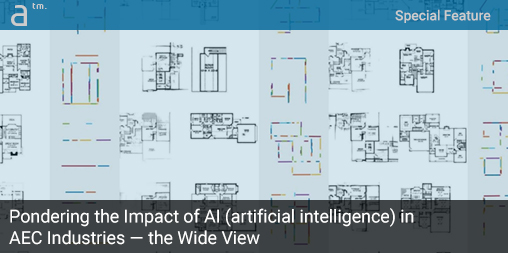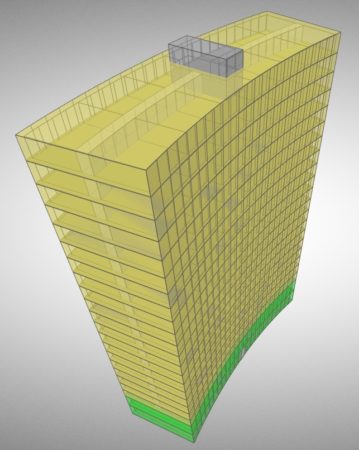AI (or Artificial Intelligence) and more specifically Machine Learning (ML) have rapidly moved to the foreground in discussions of the future of work and the effects on human life. Not a day goes by when the average person cannot find a new story on AI in a mainstream publication. Architosh collected a panel of computational design experts to discuss AI and ML and what it may mean for the field of Architecture. What follows is a broad discussion that ranges from historical roles to emerging convergences. In short, we want to know where architects stand in the AI future.
Are Architects Facing an Existential Threat by AI and ML?
When we look at architects today in the early 21st-century, we see a profession holding onto a 20th-century common sense. Despite BIM (building information modeling) and all that it has promised, they remain attached to their five phases of activity and the idea that the production of drawings is their primary basis for a livelihood. Of course, the public thinks this too. And the profession has done little to correct them. Even the industry of BIM for decades inadvertently reinforced this view. But what if this phase could be fully automated away thanks to AI and ML?
“Part of the issue is that architects today value billable production,” says Ian Keogh, CEO, and co-founder of Hypar, a new software company offering generative design solutions to the AEC industry. “Some architects will kick and scream if you were ever to introduce a technology that would take away their working drawings phase.” But this is the phase that takes the longest time before commencing with the building phase. Some software companies are already using ML to find ways to speed the work of this phase, so this is where AI comes into play.
“On the idea of billable production impeding the adoption of AI, I’d say it’s similar to the worker protests against the adoption of mechanical looms in the 19th century,” says Anthony Hauck, President, and co-founder of Hypar. “At the time, only wealthy people had several sets of clothes for different occasions, and such a small market would be instantly saturated by cloth produced at a high rate of speed.” Hauck makes the point that at the beginning of the Industrial Revolution, few realized that perhaps everyone could possess a wardrobe. “Similarly, architects conceiving of what they do as labor for wealthy people—and no one says this out loud, but it’s hard to see it otherwise, in my opinion—are naturally threatened when a method for reducing necessary labor might be on the horizon.”
In sharp contrast to this, Hauck adds: “Architects who conceive themselves as definers and solvers of problems requiring the integration of diverse expertise will do just fine, and quickly adopt any means to expand their reach and broaden their impact.”
Haucks’ analogy is intriguing. And so is the prospect that AI and machine learning (ML) could democratize good architecture and buildings for everybody and not just those who are privileged to work and live in buildings designed by the best of what the field of architecture can offer. Natasha Bajc, an architect and professor with a masters in computer science, makes another observation, “even the embroidering on a couture dress today is still done by hand just like in the Middle Ages.”
Bajc’s suggestion is both soothing and troubling. Three centuries later the couturier is still here. And architects could take additional solace in the fact that a building is several factors larger and more complex than even the most elaborate of dresses. What should trouble architects however is the notion that if computational design, infused with AI and ML, is possibly the equivalent of the mechanical loom—the great democratizer of all that Architecture can offer society—are they preparing for the new transformations of their field? Or are architects merely going to get in the way of themselves like the Luddites of the Industrial Revolution?
Are Human Architects an Insurance Policy Against Change?
Before we can answer some of those questions and the role the human architect may play in the utilization of AI and ML in this field, we might want to examine the evidence today. Do architects really embrace change? What does the media say about such change? What about the role and cultural pervasiveness of the “starchitect”? Won’t data, AI and ML run up against the intuitive superpowers of architecture’s elite and the exulted status heaped upon them by the media and the establishment?
“Given that there are really only about six of them at any given time tells you a lot about their value,” says Hauck. “If ‘starchitects’ were really valuable to the world there would be a lot of them. There are many star musicians, actors, star novelists, and yet a few superstar architects at any given time. I think its a sign of the wrong kind of economic scarcity. What they do can only be supported by a very narrow and high economic stratum.”
One of the current definitions of architects in economies is that we are ‘the insurance’ for real estate developers that the project will be just like the project before.
“For me, it comes down to what they do,” says Theodore Galanos, an engineer and international leader in advanced computational design. “For example, David Lynch for me is a brilliant filmmaker, and I love everything he does, and he deserves the accolades.” If the starchitects are actually of value because they play the role of the provocateur then in truth the field of architecture may not need many of them. Their value is in setting up established cultural expectations for the field—that some, the rare, the gifted, the chosen—are elevated socially as disruptive innovators for the good of society. But is that truly enough of social value and how does it overlay the possible innovation AI and ML may bring to the field, particularly the types of problems these emerging technologies like AI and ML could one day solve? Hauck wants to compare this more bluntly by asking—“What problems are the starchitects actually solving and for how many people?”
“We have to realize that we are a subsystem of a subsystem,” says Bajc. “One of the current definitions of architects in economies is that we are ‘the insurance’ for real estate developers that the project will be just like the project before.” This observation, while stinging, has a ring of truth to it. And the definition would apply to both mainstream architects and the work of architectural stars. After Bilbao got its Gehry museum, there was the ‘Bilbao Effect’ [great recent read here] and many other cities rushed to gain their own Gehry building to elevate their local economies.
Bajc says that the issue with the impact of AI and ML to transform the world of architecture is it must confront what she calls the ‘goal posts’ set up by establishment media and the work of starchitects. “Eisenmann will say that architects are only there to produce culture,” she adds. Galanos thinks that what they really provide is ideology. So the onslaught of emerging technologies like AI and ML in the field will either absorb, reflect, reject or subjugate the forces that currently establish ‘ideology’ or architecture culture today. New goal posts will hopefully emerge; ones that value ambitions that will enable everyone to benefit from the best that the field of architecture can generate for society.
next page: What’s Possible with AI and ML and Can Everyone Have Better Buildings?





Reader Comments
Comments for this story are closed